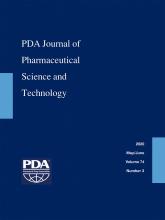Article CommentaryCommentary
Visible Particulate Contamination Control for Injectable Products: A Life-Cycle Approach
Stephen E. Langille
PDA Journal of Pharmaceutical Science and Technology May 2020, 74 (3) 359-366; DOI: https://doi.org/10.5731/pdajpst.2019.010462
Stephen E. Langille
ValSource, Inc., 918A Horseshoe Pike, Dowingtown, PA 19335

References
- 1.↵
- Woodcock J.
- 2.↵
- Langille S. E.
- 3.↵U.S. Pharmacopeial Convention, General Chapter <1> Injections and Implanted Drug Products (Parenterals) – Product Quality Tests. In USP 42–NF 37, USP: Rockville, MD, 2019.
- 4.↵Council of Europe. Parenteral Preparations, Monograph 0520. In European Pharmacopoeia (Ph. Eur.), 9th Edition, Council of Europe: Strasbourg, France, 2018.
- 5.↵Ministry of Health Labour and Welfare of Japan, General Tests, Process and Apparatus–6.06: Foreign Insoluble Matter Test for Injections. In The Japanese Pharmacopoeia, 17th Edition (English Version), MHLW: Tokyo, 2018.
- 6.↵U.S. Pharmacopeial Convention, General Chapter <790> Visible Particulates in Injections. In USP 42–NF 37, USP: Rockville, MD, 2019.
- 7.↵
- Wang H. S.
- 8.↵
- Taylor P.
- 9.↵Parenteral Drug Association Inc. Technical Report No. 79: Particulate Matter Control in Difficult to Inspect Parenterals; Bethesda, MD, 2018.
- 10.↵
- Aldrich D. S.,
- Cherris R. T.,
- Shabushnig J. G.
- 11.↵U.S. Pharmacopeial Convention, General Chapter <1790> Visible Inspection of Injections. In USP 41–NF 36, USP: Rockville, MD, 2018.
- 12.↵International Conference for Harmonisation, Quality Guideline Q8: Pharmaceutical Development. ICH Geneva, 2005.
- 13.↵U.S. Food and Drug Administration, Guidance for Industry: PAT–A Framework for Innovative Pharmaceutical Development, Manufacturing, and Quality Assurance. Center for Biologics Evaluation and Research. U.S. Department of Health and Human Services: Rockville, MD, 2004.
- 14.↵GMP Question and Answers. World Health Organization Web Site. https://www.who.int/medicines/areas/quality_safety/quality_assurance/gmp/en/ (accessed July 10, 2019).
- 15.↵U.S. Food and Drug Administration, Guidance for Industry: Quality Systems Approach to Pharmaceutical CGMP Regulations. Center for Biologics Evaluation and Research. U.S. Department of Health and Human Services: Rockville, MD, 2006.
- 16.↵U.S. Food and Drug Administration, Guidance for Industry: Process Validation: General Principles and Practices. Center for Biologics Evaluation and Research. U.S. Department of Health and Human Services: Rockville, MD, 2011.
- 17.↵European Medicines Agency, Guideline on the Sterilisation of the Medicinal Product, Active Substance, Excipient and Primary Container. EMA: London, 2019.
- 18.U.S. Food and Drug Administration, 21 CFR Part 211--Current Good Manufacturing Practice for Finished Pharmaceuticals. U.S. Department of Health and Human Services, Government Publishing Office: Washington, D.C., 2019.
- 19.Federal Food, Drug, and Cosmetic Act. U.S. Code, Sections 301-382, Title 21, 2019.
In This Issue
PDA Journal of Pharmaceutical Science and Technology
Vol. 74, Issue 3
May/June 2020
Visible Particulate Contamination Control for Injectable Products: A Life-Cycle Approach
Stephen E. Langille
PDA Journal of Pharmaceutical Science and Technology May 2020, 74 (3) 359-366; DOI: 10.5731/pdajpst.2019.010462
Jump to section
Related Articles
- No related articles found.





